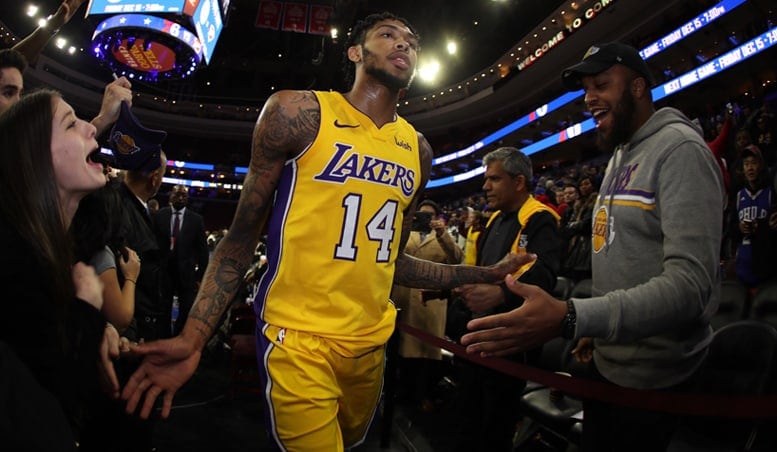One of the most important steps for young players to take is learning how to make “winning plays.”
With four minutes left in a photo finish against the Sixers, Julius Randle, Lonzo Ball and Brandon Ingram were there to provide those plays.
It all starts with the Lakers leading by just one, when Ingram uses his long strides to get a step past his defender. B.I.’s slashing causes Randle’s man to come help, and Ingram makes the right play to simply dump the ball off to Julius for the and-1 dunk.

That play got Randle going, as he scored on four straight possessions for the Lakers.
This included three consecutive pick-and-rolls for the player that leads the league in P&R points per possession (1.37).
The first one sees Ball get ahead of his man, Ben Simmons, leaving Joel Embiid out of position to stop Randle’s roll. He finishes at the hoop with a tough layup against a third defender.
Ball beats Simmons even worse on the second play and feeds Randle again. Embiid makes contact with Randle at the rim, putting the Sixers’ center one whistle away from fouling out.
Not wanting Embiid tossed, Philadelphia switches him over to guarding Ball instead of the contact-seeking Randle. But that opens up the paint for L.A.’s small-ball center.
Robert Covington tries to deny Ingram from going right on this last P&R, but Randle makes just enough contact to allow him to get by. With Embiid on the other side of the floor, Randle is given a 25-foot runway to build momentum on his roll.
Embiid steps up to contest but bails at the last second to avoid potentially fouling out. Randle hits the layup to break a 101-101 tie.
“Embiid had five fouls, so we were going to go with Ju and live and die with him going to the basket strong,” Ball said.
Here are all three of those pick-and-rolls.
For as impressive as Randle was on the offensive end, he was even more crucial defensively. Facing Embiid, the best post player in the game, Randle held his own.
Embiid scored four points with a couple of assists down the stretch, but Randle came up with two vital stops.
After Embiid completely dominated their matchup three weeks ago (finishing with 46 points), Randle altered his strategy. Five inches shorter than Embiid, he decided to make it tougher for him to get post positioning.
Here, he forces the 7-footer to catch the ball out near the 3-point line. As Embiid tries to back his way in, Randle is able to poke the ball away for the steal.

Then, with the game on the line, Randle steps up once again.
Embiid catches the ball a bit farther than he’d like, but hits Randle with a nice spin move to get to the restricted area. Still, Julius hangs with him and is able to contest his shot at the rim, giving the Lakers the ball with time running out in a tied game.
“He’s probably, from a center position, the toughest (to) guard in the league,” Randle said. “Last time, I was mad at myself for putting him on the (free throw) line.
“His catches were too easy. He was getting in the paint. This time I was just trying to make it a lot tougher and not get beat the same way twice.”

The ball pops out to Lonzo, who instinctively pushes the ball ahead, creating confusion amongst the Philadelphia defense. In particular, Embiid forgets that he had previously switched onto Ball, who gets wide open.
Embiid literally looks around for his man before realizing it’s Ball and rushes to close out on a potential 3-pointer. Lonzo takes advantage and drives.

As Ball slashes, all five Sixers defenders converge on him as if magnetized. This gravity leaves both Ingram and Kentavious Caldwell-Pope wide open.
Ball decides to go with Ingram, who makes the biggest shot of his two-year career.
Never mind that B.I. has shot just 31 percent on triples this year, Lonzo wanted the dagger in his hands.
“I say he’s the closer all the time,” Ball said. “We need a bucket, we’re going to him.”

And here is that final segment all at once.
Randle, Ball and Ingram all rise to the moment, resulting in the most impressive sequence of the season.
